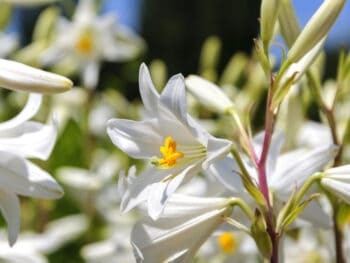Nigella’s gentle, happy presence lingering in our garden for the length of spring has moved me to write a poem. Any plant that offers this much delight to its gardener and dazzle to its garden is worthy of a wordy-flourish! I hope to pass on the flirty genius of these annuals and convince you as I have been, how wonderful they are to include among your cool-season plantings.
Growing Nigella
First, their wispy, lively green foliage sprouts to life in the early spring, populating lavishly and unassumingly the flower border beds, helping out while other perennials slowly wake up. Next, their starry-elegant flowers emerge—showy, eye-pleasing points of soft blue. Several flowers fill each stem, and they make excellent cut flowers, confirmed by our Easter dinner table.

Let pods reign as long as possible—resist bringing them all in to your #slowflowers bouquets—because all-the-while, they are secretly scattering next year’s crop! The whole bounty of our spring came from plopping my “Pot O’ Bible” Lenten Blog series sample at the edge of our flower bed after Easter last year. Surprise!
Finally, as pods become papery dry, cut and hang stalks in your pantry until delicately “beating out” the seeds to secure in a spice jar (don’t wait too long to do this). A summer of flavor awaits…see what I mean? So much to enjoy with nigella.
A-to-Z Primer of Plants from God’s Word
Read the latest addition to A-to-Z Primer of Plants from God’s Word with Nigella, also featured in our Plant Guide.
Move the cursor over the poetry text to reveal links to Scripture.
 is for nigella,
is for nigella,
the prettiest posy yet
to grace in rhyme and meter
the Bible-plants alphabet.
This nice garden flourish
you might not know by name;
black cumin, fennel flower, or nutmeg plant—
Nigella sativa, all the same.
Confusion continues garden to table,
where chefs find it hard to settle
on black seed, nigella, or Roman coriander
once seeds form after petals.
Nonetheless, this savory spice
is a favorite in the Middle East.
Toasted seeds sprinkled a-top breads
flavor the nightly feast.
In the garden, scatter black seeds
in the coolness of the season.
The showy display of star-blue flowers
is more than enough reason
to grow these dainty, dazzling blooms.
Yet just when the blossoms fade,
puffed seed pods form, tall and bright,
standing noble in the glade
 with a pale green crown of filiform foliage
with a pale green crown of filiform foliage
and subtle crimson stripes.
Outstanding back-to-back drama—
flowers and pods nudge garden delight!
Though in God’s Word, nigella was grown
in the field alongside cumin.
Often translated “caraway “ or “fitches,”
these crops revealed God’s acumen
for agricultural practices and His
knowledge of every dimension,
nurturing care for grains and spices
and their nuance: Pay attention.
Plow, but not continually;
break up the soil, though don’t keep on.
Seeds must be sown, planted in place,
and growing time may seem long,
yet harvest and threshing surely follow;
and this, too, not forever.
Who has such instruction? And who
can inform the farmer’s endeavors?
Beat out with a stick, a rod—
or roll under the wheel of a cart?
The savvy of knowing exact tools to employ
is teaching that the LORD imparts.
He knows, He notices every detail—
remember the starry host?
He calls them by name, one by one,
not one missing from His post.
No one can fathom His understanding
and He is generous and willing to share
His wonderful plans, His magnificent wisdom,
the specifics of when, how, and where.
Precious nigella, lovely flowers,
pleasantly drawing us near
to the LORD Almighty, the Everlasting God,
Caregiver to all we hold dear.
For I am the Lord your God who takes hold of your right hand and says to you, Do not fear; I will help you.
Isaiah 44:13 NIV
Read more on nigella in the devotions on Intimacy with God in the Garden, part of Garden Stories, pages a-48 & a-49
Find more garden-to-table information on growing nigella in our Plant Guide – visit www.gardenindelight.com/plant-guide/nigella/
Photo Credits: ©2017 Shelley S. Cramm



















Thank you for posting.